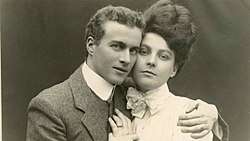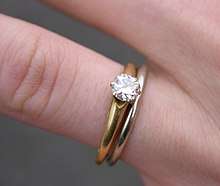Engagement
An engagement or betrothal is the relationship between two people who want to get married, and also the period of time between a marriage proposal and a marriage. During this period, a couple is said to be fiancés (from the French), betrothed, intended, affianced, engaged to be married, or simply engaged. Future brides and grooms may be called fiancée (feminine) or fiancé (masculine), the betrothed, a wife-to-be or husband-to-be, respectively. The duration of the courtship varies vastly, and is largely dependent on cultural norms or upon the agreement of the parties involved.
_-_The_Proposal_(1872).jpg)
Long engagements were once common in formal arranged marriages, and it was not uncommon for parents betrothing children to arrange marriages many years before the engaged couple were old enough. This is still common in some countries.
Origin
.jpg)
The origins of European engagement in marriage practice are found in the Jewish law (Torah), first exemplified by Abraham, and outlined in the last Talmudic tractate of the Nashim (Women) order, where marriage consists of two separate acts, called erusin (or kiddushin, meaning sanctification), which is the betrothal ceremony, and nissu'in or chupah,[lower-alpha 1] the actual ceremony for the marriage. Erusin changes the couple's interpersonal status, while nissu'in brings about the legal consequences of the change of status. (However, in the Talmud and other sources of Jewish law there is also a process, called kiddushin, corresponding to what today is called engagement. Marrying without such an agreement is considered immoral.[1] To complicate matters, erusin in modern Hebrew means engagement, not betrothal.)
This was later adopted in Ancient Greece as the gamos and engeysis rituals, although unlike in Judaism the contract made in front of witness was only verbal.[2] The giving of a ring was eventually borrowed from Judaism by Roman marriage law, with the fiancé presenting it after swearing the oath of marriage intent, and presenting of the gifts at the engagement party.[3]
Betrothal
.jpg)
Betrothal (also called espousal) is a formal state of engagement to be married.
In Jewish weddings during Talmudic times (c.1st century BC – 6th century AD), the two ceremonies of betrothal (erusin) and wedding usually took place up to a year apart; the bride lived with her parents until the actual marriage ceremony (nissuin), which would take place in a room or tent that the groom had set up for her. Since the Middle Ages the two ceremonies have taken place as a combined ceremony performed in public. The betrothal is now generally part of the Jewish wedding ceremony, accomplished when the groom gives the bride the ring or another object of at least nominal value.[4] As mentioned above, betrothal in Judaism is separate from engagement; breaking a betrothal requires a formal divorce, and violation of betrothal is considered adultery.
Typical steps of a match were the following:
- Negotiation of a match, usually done by the couple's families with bride and groom having varying levels of input, from no input, to veto power, to a fuller voice in the selection of marriage partner.
- Negotiation of bride price or dowry
- In most cultures evolved from Europe, bride prices or dowries have been reduced to the engagement ring accompanying the marriage contract, while in other cultures, such as those on the Arabian Peninsula, they are still part of negotiating a marriage contract.
- Blessing by the parents and clergy
- Exchange of Vows and Signing of Contracts
- Often one of these is omitted
- Celebration

The exact duration of a betrothal varies according to culture and the participants’ needs and wishes. For adults, it may be anywhere from several hours (when the betrothal is incorporated into the wedding day itself) to a period of several years. A year and a day are common in neo-pagan groups today. In the case of child marriage, betrothal might last from infancy until the age of marriage.
The responsibilities and privileges of betrothal vary. In most cultures, the betrothed couple is expected to spend much time together, learning about each other. In some historical cultures (including colonial North America), the betrothal was essentially a trial marriage, with marriage only being required in cases of conception of a child. Almost all cultures are loosening restrictions against physical contact between partners, even in cultures that normally had strong prohibitions against it. The betrothal period was also considered to be a preparatory time, in which the groom built a house, started a business or otherwise proved his readiness to enter adult society.
In medieval Europe, in canon law, a betrothal could be formed by the exchange of vows in the future tense ("I will take you as my wife/husband," instead of "I take you as my wife/husband"), but sexual intercourse consummated the vows, making a binding marriage rather than a betrothal. Although these betrothals could be concluded with only the vows spoken by the couple, they had legal implications: Richard III of England had his older brother's children declared illegitimate on the grounds their father had been betrothed to another woman when he married their mother.
A betrothal is considered to be a 'semi-binding' contract. Normal reasons for invalidation of a betrothal include:
- Revelation of a prior commitment or marriage
- Evidence of infidelity
- Failure to conceive (in 'trial marriage' cultures)
- Failure of either party to meet the financial and property stipulations of the betrothal contract
Normally, either party can break a betrothal, though some financial penalty (such as forfeit of the bride price) usually applies. In some common law countries, including England and Wales and many US states, it was once possible for the spurned partner (often only the woman) to sue the other for breach of promise or "heart-balm". This provided some protection in an age where virginity at marriage was considered important and having a failed engagement could damage one's reputation, but this tort has become obsolete in most jurisdictions as attitudes to premarital sex have softened and emphasis shifted to allowing people to leave loveless relationships.[5]
Protestant Churches
The Rite of Betrothal in the Anglican Communion is found within The Book of Common Prayer, first published in 1549.[6] The Anglican Communion, as well as the Methodist Church and Presbyterian Church, has questions and responses for family members in its Rite of Betrothal.[7]
Orthodox Churches
In the Eastern Orthodox and Oriental Orthodox Churches, the Rite of Betrothal is traditionally performed in the narthex (entranceway) of the church, to indicate the couple's first entrance into the married estate. The priest blesses the couple and gives them lit candles to hold. Then, after a litany, and a prayer at which everyone bows, he places the bride's ring on the ring finger of the groom's right hand, and the groom's ring on the bride's finger. The rings are subsequently exchanged three times, either by the priest or by the best man, after which the priest says a final prayer. Originally, the betrothal service would take place at the time the engagement was announced. In recent times, however, it tends to be performed immediately before the wedding ceremony itself. The exchange of rings is not a part of the wedding service in the Eastern Churches, but only occurs at the betrothal. Traditionally, the groom's ring is gold and the bride's ring is silver.[8]

Catholic Church
Historically, betrothal in Roman Catholicism was a formal contract considered as binding as marriage, and a divorce was necessary to terminate a betrothal.[9] Betrothed couples were regarded legally as husband and wife – even before their wedding and physical union. The concept of an official engagement period in Western European culture may have begun in 1215 at the Fourth Lateran Council, headed by Pope Innocent III, which decreed that "marriages are to be ... announced publicly in the churches by the priests during a suitable and fixed time so that, if legitimate impediments exist, they may be made known."[10][11] Such a formal church announcement of the intent to marry is known as banns. In some jurisdictions, reading the banns may be part of one type of legal marriage.
Engagement rings

Customs for engagement rings vary according to time, place, and culture. An engagement ring has historically been uncommon, and when such a gift was given, it was separate from the wedding ring.
The first recorded tradition of giving a ring for marriage is in Genesis 24:22 of the Hebrew Bible when a golden nose ring (Chayei Sarah 24:22) was given by Eliezer of Damascus to Rebecca,[12] with Saadiah Gaon also citing as a possible source of the practice in the phrase in Nehemiah 7:46 be’nei tabbaot (children of the rings). The latter case refers to betrothal (see above) rather than engagement; one of the three ways in which betrothal may be effected in Judaism is by the husband giving the bride money or an object of at least nominal value. In fact, it is a long-standing practice within Judaism to contract the betrothal with a ring.
Romantic rings from the time of the Roman Empire sometimes bore clasped hands symbolizing contract,[13] from which the later Celtic Claddagh symbol (two hands clasping a heart) may have evolved as a symbol of love and commitment between two people. Romans believed the circle was a bond between the two people who were to be married and signified eternity, but was first practiced on the fourth finger/ring finger by the Romans, who believed this finger to be the beginning of the vena amoris ("vein of love"), the vein that leads to the heart.[14] In cultures with European origin, and many other countries, an engagement ring is worn following the practice of the Romans who "...wore the ring either on the right middle finger or the left ring [4th] finger, from which, according to ancient Egyptian physicians, a nerve led directly to the heart."[14] The custom in Continental Europe and other countries is to wear it on the right hand. One historical exception arose in monarchical regimes, in which a nobleman entering into morganatic marriage, a marriage in which the person, usually the woman, of lower rank stayed at the same rank instead of rising ranks, would present their left hand to receive the ring, hence the alternative term 'marriage with the left hand' (Ger. Ehe zur linken Hand), the offspring of such marriages considered to be disinherited from birth.[15]
The modern Western form of the practice of giving or exchanging engagement rings is traditionally thought to have begun in 1477 when Maximilian I, Holy Roman Emperor, gave Mary of Burgundy a diamond ring as an engagement present.[16]
In other countries like Argentina, men and women each wear a ring similar to wedding bands. They are made of silver ("alianza de plata") when manifesting an informal "boyfriend-girlfriend" relationship, though this first step might not always happen; howbeit depending on finances, this may be the only ring given at all. The gold band ("anillo de compromiso" or "alianza de oro") is given to the bride when the commitment is formal and the [optional] diamond ring ("cintillo") is reserved for the wedding ceremony when the groom gives it to the bride. The gold band that the groom wore during the engagement – or a new one, as some men choose not to wear them during engagement – is then given to the groom by the bride; and the bride receives both the original gold band and the new diamond at the ceremony. The bride's diamond ring is worn on top of the engagement band at the wedding and thereafter, especially at formal occasions or parties; otherwise the engagement band suffices for daily wear for both parties. At the wedding, the rings are swapped from the right to the left hand. In Brazil, they are always made of gold, and there is no tradition for the engagement ring. Both men and women wear the wedding band on their right hand while engaged, and, after they marry, they shift the rings to their left hands. In Nordic countries such as Finland and Norway, both men and women wear an engagement ring.
In the modern era, some women's wedding rings are made into two separate pieces. One part is given to her to wear as an engagement ring when she accepts the marriage proposal and the other during the wedding ceremony. When worn together, the two rings look like one piece of jewelry. The engagement ring is not worn during the wedding ceremony, when the wedding ring is put by the groom on the finger of the bride, and sometimes by the bride onto the groom's finger. After the wedding, the engagement ring is put back on, and is usually worn on the outside of the wedding ring.
Engagement parties
Some engagements are announced at an engagement party, traditionally hosted by the bride's parents. These parties are given in the family's usual style of entertainment. Traditionally, engagement parties were normal parties at which a surprise announcement of the engagement was made by the father of the bride to his guests. Therefore, it is not a traditional gift-giving occasion since no guests were supposed to be aware of the engagement until after their arrival.
In modern times, engagement parties often celebrate a previously publicized engagement. Whether presents are given at these engagement parties varies from culture to culture.
Notes
| Wikimedia Commons has media related to Betrothal. |
- To be precise, nesiuin is the process, and chuppah is the method.
Citations
- Kaplan, Rabbi Aryeh (1983). Made in Heaven, A Jewish Wedding Guide. New York / Jerusalem: Moznaim Publishing., Chapter 4, See also footnote 1 and 2. The author uses the specific term proposal, and considers this the first step in a formal engagement.
- Norman Bancroft Hunt, Living in Ancient Greece, Infobase Publishing, 2008, p.44
- Philippe Ariès, Paul Veyne, eds., A History of Private Life: From pagan Rome to Byzantium, Harvard University Press, 1992, p.467
- See Talmud Kiddushin, Mishna 1:1 and the main article
- Nancy R. Gallo (2004). "Left at the Altar". Introduction to Family Law. Cengage Learning. pp. 114–116. ISBN 1401814530.
- Hefling, Charles; Shattuck, Morehouse Cynthia (1 July 2006). The Oxford Guide to The Book of Common Prayer. Oxford University Press. p. 510. ISBN 9780199723898.
- Prichard, Robert W. (1 January 2009). Cohabiting Couples and Cold Feet: A Practical Marriage-Preparation Guide for Clergy. Church Publishing, Inc. p. 107. ISBN 9780898696035.
The Episcopal Book of Common Prayer of 1979 reworked the betrothal by adding a positive question to the congregation immediately after the couple speaks their words of betrothal. The celebrant asks the congregation, "Will all of you witnessing these promises do all in your power to uphold these two persons in their marriage?" The congregation's response is, "We will." This inquiry was expanded in The United Methodist Hymnal (1989) and the Presybterian Book of Common Worship (1993) into separate questions for family members and for other members in the congregation.
- Hapgood, Isabel F. (1922). "Service Book of the Holy Orthodox-Catholic Apostolic Church". Englewood, NJ: Antiochian Orthodox Christian Archdiocese (published 1975): 291 ff, 604–5. Cite journal requires
|journal=(help) - Askelm.com
- Medieval Sourcebook: Twelfth Ecumenical Council: Lateran IV 1215
- Utunumsint.org Archived 2006-07-12 at the Wayback Machine
- Herczeg, Y.I.Z, The Torah: with Rashi's commentary, Vol.1, Mesorah Publications, New York, 2000, p. 253
- Catherine Johns, The jewellery of Roman Britain: Celtic and classical traditions, Routledge, 1996, p. 63–64
- Philippe Ariès, Paul Veyne, A History of Private Life: From pagan Rome to Byzantium, Harvard University Press, 1992, p.467
- Marie Maclean, The name of the mother: writing illegitimacy, Routledge, 1994, p. 191
- Michael R Collings, Gemlore: An Introduction to Precious and Semi-Precious Stones, Wildside Press LLC, 2009, p. 50